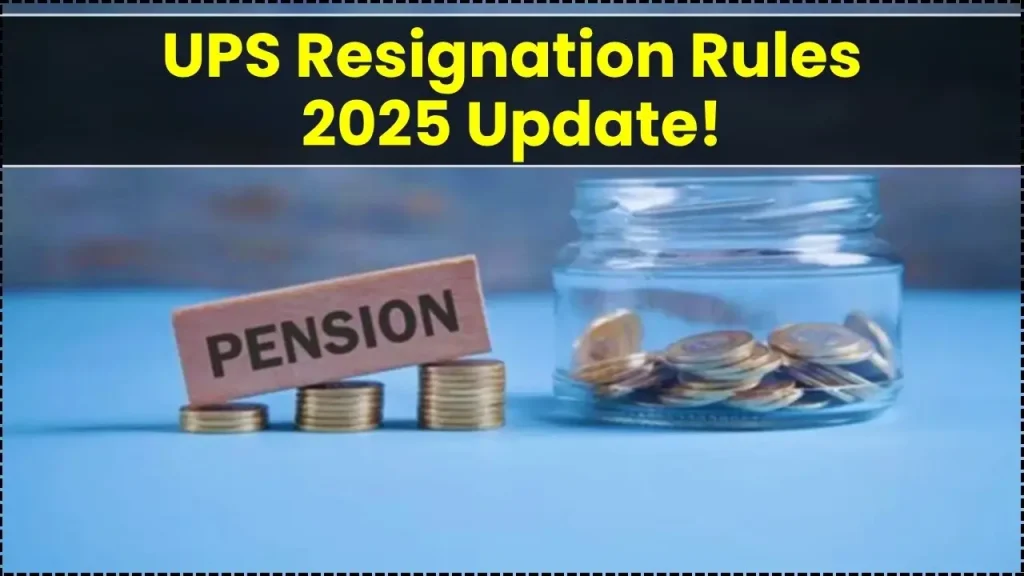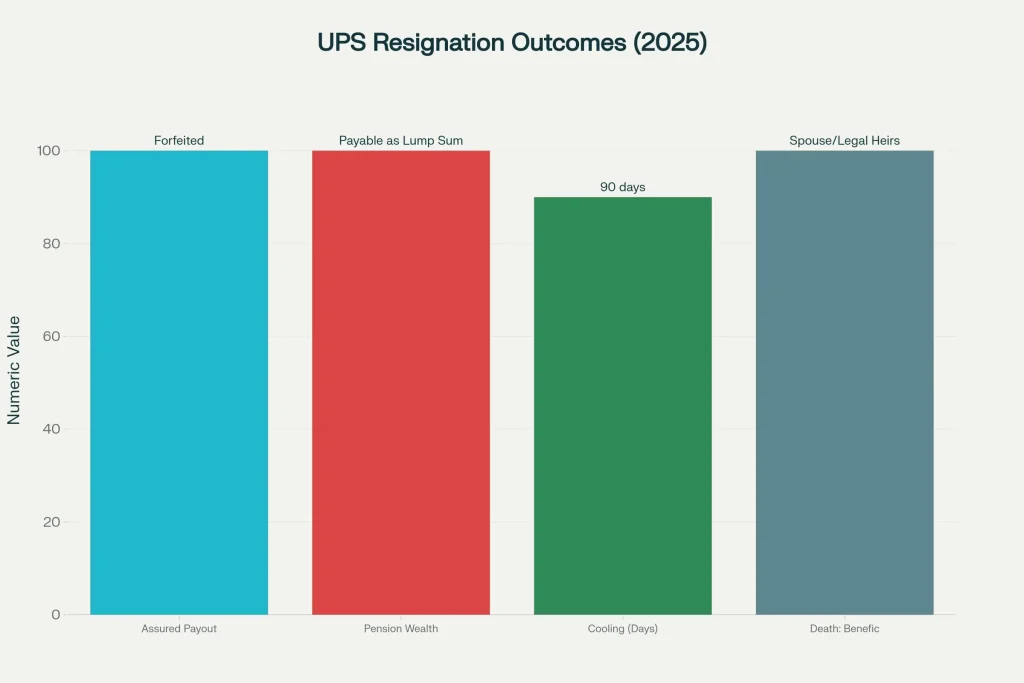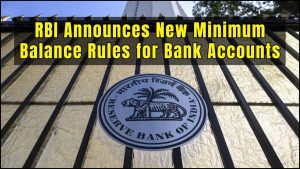Thinking about quitting government service after opting into the Unified Pension Scheme? Here’s the hard truth upfront: under the UPS resignation rules, the assured payout your guaranteed pension is normally forfeited if you resign, while your accumulated pension wealth in the corpus is still payable as a lump sum after a defined waiting period. That distinction between the guaranteed benefit and your built-up corpus is exactly what determines how much you truly lose versus what remains available to you. The operational details timelines, exceptions, and who gets paid in case of death are equally crucial for planning your exit.

United Pension Scheme resignation rules are designed to clearly separate resignation from retirement scenarios where guarantees apply. In simple terms, resignation usually switches off the UPS guarantee but leaves your individual corpus intact for a lump-sum claim after a cooling period. That waiting window serves verification and compliance needs, and there are narrow exceptions where resignation may be withdrawn in public interest. United Pension Scheme resignation rules also intersect with the limited, one-time switch option back to NPS during service useful for portability, but it ends UPS guarantees going forward.
United Pension Scheme resignation rules make one point crystal clear: resignation entails forfeiture of the assured payout unless the appointing authority allows withdrawal of the resignation in public interest. What remains payable is the accumulated pension wealth sitting in your individual corpus. It’s released only after 90 days from the date the resignation takes effect and you’re formally relieved. If a subscriber passes away within those 90 days, the corpus goes to the legally wedded spouse, or if none, to legal heirs. These rules sit within the UPS framework introduced in 2025 and align with clarified government guidance on resignation, entitlement, and switching back to NPS under specific windows.
UPS Resignation Rules
| Key Point | What It Means |
|---|---|
| Legal Basis | Resignation under UPS for Central Government employees leads to forfeiture of the assured payout unless the resignation is withdrawn in public interest by the appointing authority. |
| Forfeiture | The guaranteed pension/assured payout under UPS is forfeited on resignation. |
| Payable Amount | Accumulated pension wealth (employee + government contributions) remains payable as a lump sum. |
| Payment Timing | Lump sum can be paid only after 90 days from the effective resignation date and formal relieving. |
| Death Within 90 Days | Corpus is paid to the legally wedded spouse or, if no spouse exists, to legal heirs. |
| Switch Back To NPS | A one-time, one-way switch to NPS during service is allowed at defined points; UPS guarantees then cease. |
| Effective Year | UPS is operational for Central Government employees from 2025 with clarifications issued the same year. |
United Pension Scheme resignation rules are straightforward once you separate the guaranteed benefit from the investment corpus. Resignation shuts off the guarantee but preserves your corpus for a lump-sum payout after the statutory wait. If preserving the assured payout matters to you, explore formal withdrawal of resignation in public interest or evaluate the strategic switch window to NPS during service. Above all, plan ahead align your cash flow with the 90-day timeline, keep records tight, and choose the path that fits your long-term retirement strategy.
What Exactly Do You Forfeit on Resignation
Under UPS, the assured payout is the guaranteed retirement benefit calculated under scheme conditions. On resignation, that guarantee is turned off unless the appointing authority explicitly withdraws your resignation in public interest. That’s the actual forfeiture. What you don’t lose is the pension wealth already accumulated in your account while you were under UPS. Because the guarantee is gone, there’s no UPS-based annuity on resignation what you get is the corpus as a lump sum after the waiting period.
What You Still Receive If You Resign
Even after forfeiting the guaranteed pension, your accumulated pension wealth is still yours. It comprises your own contributions and the government’s contributions credited during your UPS tenure. This amount is paid out as a single lump sum, not as an assured annuity, and only after 90 days from the effective resignation date and formal relieving. Expect standard verification and compliance checks before disbursal, so keep your KYC, bank details, and service records clean and updated.
The 90-Day Timeline and Why It Matters
The 90-day cooling period starts once two conditions are met: your resignation takes effect and you are formally relieved. This interval is built in for administrative verification, finalization of service records, and compliance safeguards. For your planning, that means factoring in at least three months before you can receive the lump sum. If you’re counting on the corpus for immediate obligations, arrange interim liquidity and avoid timing pitfalls caused by documentation delays or unclear relieving orders.
Death During the Cooling Period
If the subscriber dies before the 90 days are up, the accumulated pension wealth is paid to the legally wedded spouse. If there is no spouse, it goes to legal heirs. This preserves family access to the full corpus even though the assured payout tied to UPS is forfeited on resignation. Keep your nominee details, marital status records, and documentation current to prevent delays or disputes in settlement.
When Resignation May Not Forfeit Benefits
There are narrow, rule-bound scenarios where resignation might be withdrawn in public interest by the appointing authority. Only a formal withdrawal preserves eligibility for the assured payout. Historically, service rules also recognize specific transitions made with proper permission, but these are tightly defined and must be explicitly approved. If you’re moving to another qualifying post or exploring a rule-based exception, secure written approvals well in advance.
One-Time Switch Back To NPS: Strategic Use Cases
UPS subscribers have a one-time, one-way option to switch back to NPS during service at specified windows, such as a defined period before superannuation, before deemed voluntary retirement, or at resignation/FR 56(j) not imposed as a penalty. Exercising this switch ends UPS guarantees going forward. Employer contributions then follow NPS norms (generally 14%), and subsequent exits are governed by NPS regulations, not UPS. This can be a smart move if you value portability, flexible investment choices, and NPS exit options over UPS guarantees.

United Pension Scheme Resignation Rules in Practice
Put the rules into a real scenario. Suppose you resign with five years of service under UPS. The assured payout is forfeited; you cannot claim any guaranteed pension under UPS. Your accumulated pension wealth your and the government’s contributions remains payable, but only after 90 days from your effective resignation and formal relieving. If you die on day 45 of that period, your spouse (or legal heir if no spouse exists) receives the corpus. If, before your resignation is processed, the appointing authority withdraws your resignation in public interest, your eligibility for the assured payout remains intact as per UPS conditions.
How Much Do United Pension Scheme Subscribers Forfeit If They Resign
In outcome terms, you forfeit the entire assured payout under UPS that is, the guaranteed pension benefit stream you would have received on retirement under the scheme. You do not forfeit your accumulated pension wealth. Think of it this way: UPS offers two value layers an assured payout (the guarantee) and an investment corpus. Resignation typically deletes the guarantee layer, leaving the corpus layer intact for a lump-sum withdrawal after the statutory waiting period.
Checklist Before You Resign Under UPS
- Confirm whether the appointing authority would consider withdrawing your resignation in public interest; this is the only way to preserve the assured payout after submitting a resignation.
- Plan liquidity for the 90-day wait before your corpus can be released; it’s not immediate.
- Update KYC, nominee, marital status, and bank details to eliminate processing delays.
- Keep copies of acceptance letters, effective dates, and relieving orders gaps here can reset timelines.
- Consider using the one-time switch to NPS if portability and different exit rules suit your goals better than UPS guarantees.
- If moving to another role, confirm whether service rules and permissions might protect your benefits; get approvals in writing.
PM Modi Launches ₹62,000 Crore Youth Development Schemes in Bihar: Check Details
Key Takeaways For UPS Subscribers
- Resignation normally means losing the UPS assured payout; the guarantee doesn’t survive a standard resignation.
- Your accumulated pension wealth remains payable as a lump sum post a 90-day cooling period starting from effective resignation and formal relieving.
- Death within the 90-day period shifts the corpus payment to your spouse or, failing that, legal heirs.
- A one-time, one-way switch back to NPS is available at prescribed windows, but it ends UPS guarantees thereafter.
- Documentation discipline—resignation acceptance, relieving orders, KYC, nominee details directly affects your payout timeline and accuracy.
FAQs on UPS Resignation Rules
Do UPS resignation rules forfeit my entire pension?
No. You forfeit the assured payout (the guaranteed pension) but retain the right to your accumulated pension wealth, paid as a lump sum after 90 days from effective resignation and formal relieving.
When exactly will I receive the lump sum?
After 90 days from the effective resignation date and after you’re formally relieved. The countdown relies on both conditions being met and proper documentation.
Who gets the corpus if I die within 90 days of resignation?
Your legally wedded spouse gets it; if there is no spouse, your legal heir(s) receive it as per the rules.
Can I keep the UPS guarantee if I switch to NPS?
No. Switching to NPS ends UPS guarantees going forward. You’ll receive employer contributions as per NPS and follow NPS exit rules.
















